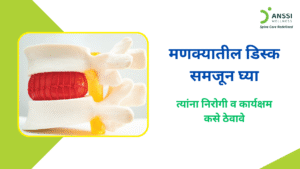Spondylitis is a progressive inflammatory condition that primarily affects the spine and sacroiliac joints. Over time, this chronic condition can lead to spinal stiffness, persistent pain, and significantly reduced mobility, impacting a person’s daily life. Though often considered a disease of the joints, spondylitis can have far-reaching effects, even beyond the spine, if left unaddressed.
Recognising the early warning signs is essential, as timely intervention can help slow progression, manage symptoms, and prevent long-term complications.
Understanding Spondylitis
Spondylitis, including ankylosing spondylitis (AS), is part of a group of inflammatory diseases known as spondyloarthropathies. Unlike mechanical back pain caused by injury or overuse, spondylitis stems from inflammation in the spinal joints and ligaments.
As the disease progresses, the body can attempt to repair the inflamed tissue by forming new bone, which may eventually lead to the fusion of spinal segments. This fusion reduces flexibility and may result in a stooped posture and severe mobility restrictions.
While the exact cause of spondylitis is unknown, genetic factors play a major role. The HLA-B27 gene is commonly associated with this condition, though not everyone with the gene will develop the disease.
Early Warning Signs You Shouldn’t Ignore
Spondylitis often begins subtly, and early signs can easily be mistaken for common back pain or simple muscle strain. However, certain features set inflammatory back pain apart from other types.
Here’s what to watch for:
- Persistent Lower Back Pain: One of the most common early signs, this pain usually develops gradually over weeks or months, not suddenly from a specific injury. It often starts in the lower back or buttocks and may alternate sides.
- Morning Stiffness: Sufferers frequently report stiffness upon waking, which can last for more than 30 minutes. Unlike stiffness from poor posture or strain, spondylitis-related stiffness typically improves with movement and worsens with rest.
- Pain That Improves with Activity: While most mechanical back pain worsens with movement, inflammatory back pain often improves with physical activity and exercise. Long periods of sitting or lying down can actually intensify the discomfort.
- Reduced Flexibility: As the inflammation persists, you may notice a gradual loss of spinal flexibility. Simple movements, like bending to tie your shoes or twisting your torso, can become more difficult over time.
- Pain Spreading to Hips and Shoulders: In some cases, the inflammation may extend beyond the spine, causing discomfort in the hips, shoulders, or chest. Rib cage involvement can even make it painful to take deep breaths.
- Fatigue and General Discomfort: Chronic inflammation taxes the body, leading to general fatigue, a sense of malaise, or reduced energy levels, even without obvious physical exertion.
- Eye Inflammation (Uveitis): Though less common, some individuals with spondylitis may develop eye inflammation, causing redness, pain, light sensitivity, and blurred vision. Left untreated, this can lead to vision problems.
Why Early Detection Matters
Ignoring the early signs of spondylitis can have long-term consequences. As the disease progresses, spinal segments can fuse, leading to a rigid and inflexible spine. This not only limits mobility but also increases the risk of fractures and spinal deformity.
Moreover, untreated inflammation can extend beyond the spine to involve other joints, tendons, and even organs such as the eyes, heart, and lungs. Chronic pain and stiffness can disrupt sleep, reduce productivity, and severely impact mental health, contributing to anxiety or depression.
Early detection allows patients to manage symptoms effectively and slow disease progression. Lifestyle modifications, targeted therapies, and non-invasive treatments can all play a crucial role in maintaining spinal health and overall well-being.
When Should You Seek Help?
While occasional back discomfort is common and often harmless, certain features should prompt you to seek professional evaluation:
- Pain that persists beyond a few weeks, especially if it gradually worsens
- Stiffness that worsens after periods of inactivity or in the morning
- Pain that improves with movement but gets worse with rest
- Difficulty performing everyday movements or reduced range of motion
- Any associated symptoms such as unexplained fatigue, eye pain, or joint swelling
If you notice these warning signs, consult a specialist familiar with spinal conditions. Early assessment, including physical examination and imaging studies, can help confirm a diagnosis and guide appropriate management.
Non-Surgical Solutions for Spondylitis
Spondylitis can often be managed effectively with non-surgical treatments that focus on reducing inflammation, relieving pain, and improving spinal flexibility.
Such treatments include the following.
- Physical therapy exercises can be designed to maintain posture, flexibility, and strength, helping reduce stiffness and prevent further spinal damage.
- Lifestyle modifications, such as ergonomic improvements and regular low-impact activities, can further ease symptoms.
- Heat and cold therapy, along with mindfulness-based techniques or relaxation exercises, may help manage pain and stress.
- Non-Surgical Spinal Decompression Treatment (NSSDT) is a gentle, computer-controlled procedure that stretches the spine to reduce pressure on discs, nerves, and joints. This promotes hydration, nutrient flow, and healing in affected spinal tissues without medications, injections, or surgery.
About ANSSI:
ANSSI Wellness focuses on improving the quality of life for patients suffering from spinal issues, aiming to provide relief where other conventional treatments have failed. Through advanced non-surgical spinal decompression treatment, ANSSI is committed to helping patients avoid surgery and recover in a safe, effective, and compassionate environment.
Connect with ANSSI Wellness on LinkedIn, Instagram, and Facebook for expert guidance.



